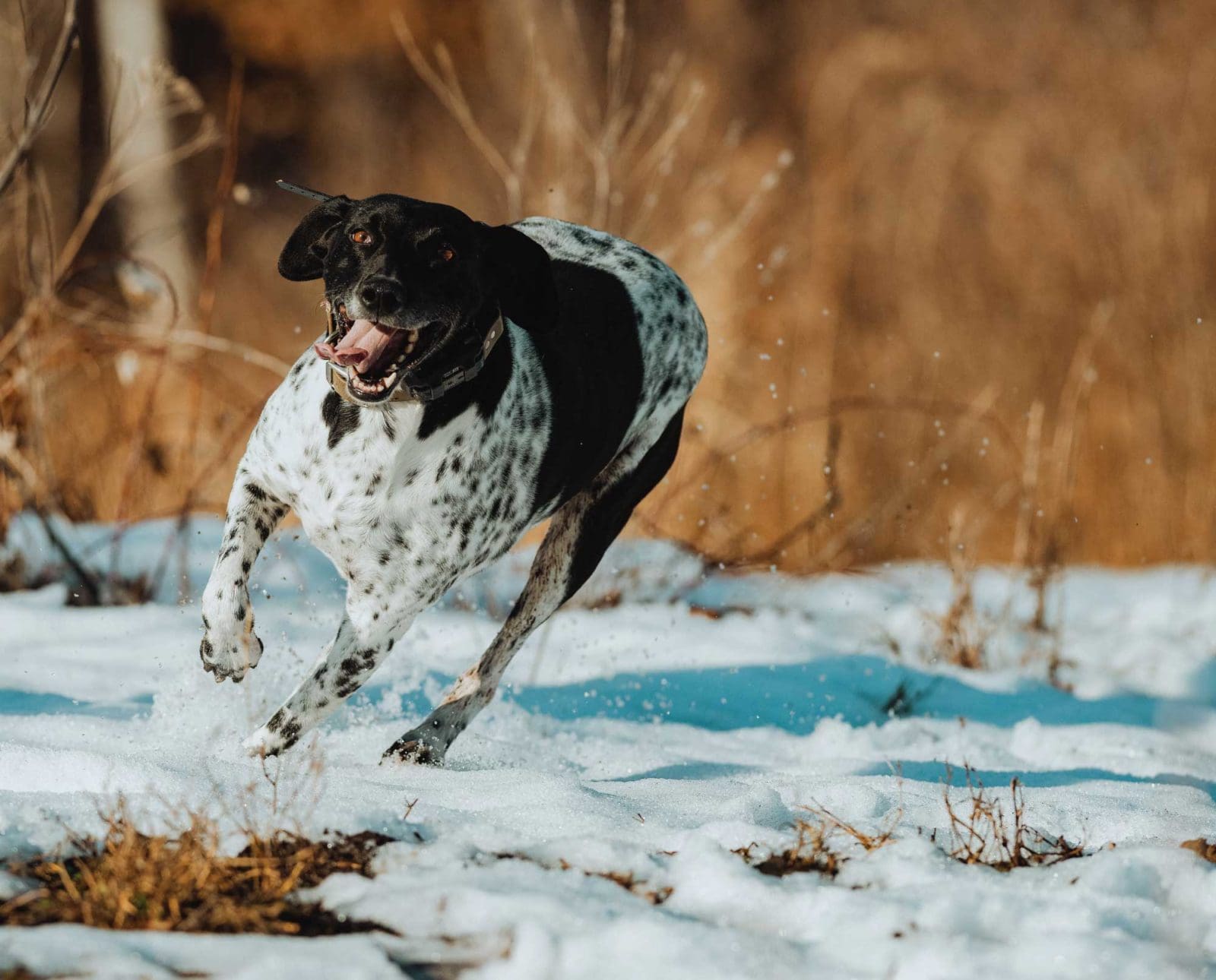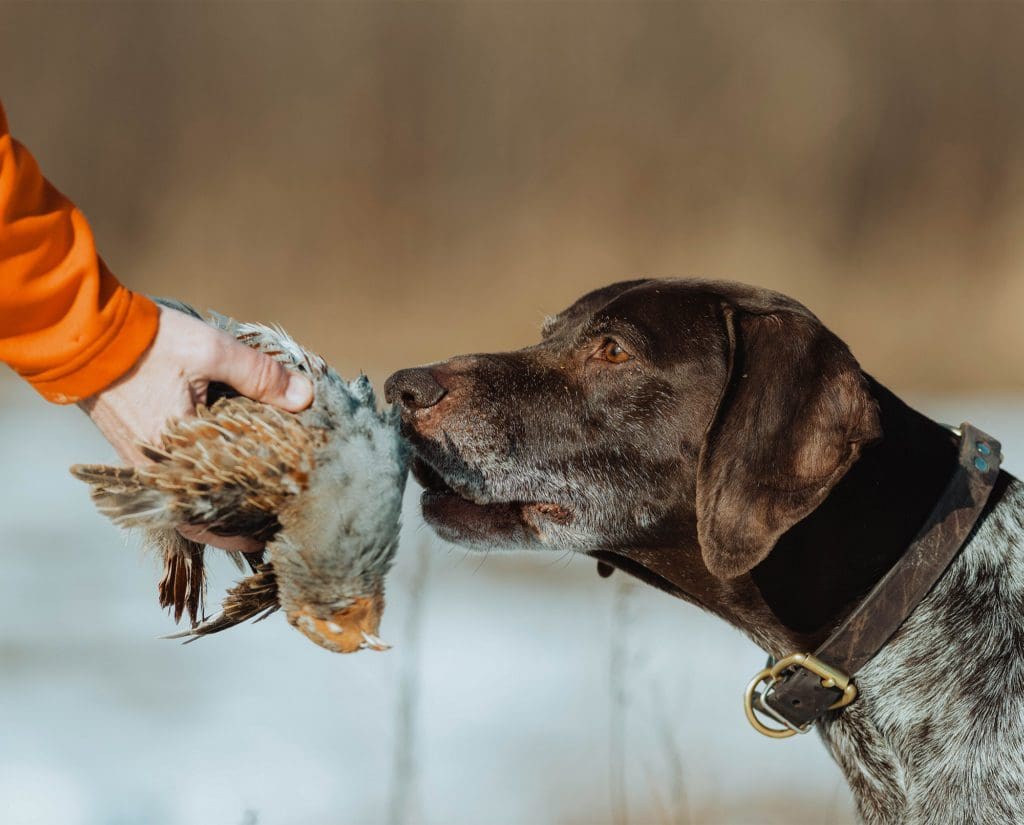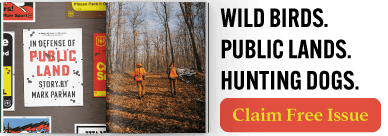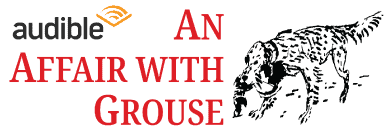Home » Hunting Dogs » How to Keep a Hunting Dog Conditioned in the Winter
How to Keep a Hunting Dog Conditioned in the Winter

Jason Carter is a NAVHDA judge, NADKC member, director of…
From the peaks of Alaska to the bayous of Louisiana, dog trainers and experts discuss the necessity of keeping a hunting dog conditioned.
For many of us in the northern snow-covered hills of the United States, hunting season is shortly coming to an end—if not already. Green rolling pastures have now been replaced by a tundra; the woodcock have all traveled down to warmer, worm-filled bayous; and the grouse are retreating to the treetops.
Listen to more articles on Apple | Spotify
Now entering your home, you will likely be met by familiar eyes: your hunting dog staring back at you for a sign that you are gearing up for a hunt. As your dog realizes that you are settling in for the evening, you can see its disappointment. Soon it slinks to its bed in protest, curling into a ball with a dejected sigh, resigning to the fact that there has been a change in the routine. A feeling of guilt fills your soul as your dog was at its happiest pursuing birds for you, so, of course, you head to the cookie jar to let Ol’ Red know just how sorry you are. Your once chiseled athlete has de-evolved into somewhat of a bratwurst shape.
Ol’ Red—now more affectionately known as “Mr. Weeble Wobble”—needs more than a little attention to get back down to his fighting weight.
Yet, winter in the north can be a very productive time for both you and your dog. The snow provides a multitude of training opportunities, helping to fill some of the holes found during hunting season. Working forest searches, obedience, various lining drills, and hand signals are just a few great training opportunities the snow can provide. It creates visual lines and boundaries that paint a very clear picture for your dog and helps work both the brain and body. The snow also provides a fantastic opportunity to hit the trails for various thrilling adventures full of excitement and laughter for you and your family, while conditioning you both.
The timing and types of conditioning vary greatly between regions, however. When the north is adjusting to the off-season, the south is firing up for the hunt. Where the north is using snowshoes and dogsleds, the south is using four-wheelers and horses. The cold, snow, and ice create a dangerous conditioning environment in the north worth considering, as do the heat, cactus, snakes, and gators in the south. Though conditions may vary, the importance of proper conditioning remains universal across the regions and around the world.
Off-season conditioning in Seward, Alaska
Dori Hollingsworth, one of the lead trainers at the Alaska Northern Lights Chapter of NAVHDA and IFSS sleddog World Champion believes that a “well-bred, well-fed, and well-conditioned dog will be less prone to injury in the field,” but noted that there is such a thing as over-conditioning.
“Most won’t come near that,” she said. “An over-conditioned dog has to find a way out. It may show up as refusals or just sluggish work; over-conditioning can be physical or mental.”
So, what’s the best training for a hunting dog in the Last Frontier?
“Of course, the best conditioning for us in Alaska is to just go hunting, but sometimes conditions don’t allow it,” Hollingsworth said. “If you want your dog to be ready to go on that long hunt once the weather improves, you need to keep them conditioned in between. Since our hunting season is so long—Aug. 10 to March 31—we may take a break from hunting in the darkest, coldest months, and then pick it up again in the spring. We don’t take a break from the dogs working, though. Going from a cold to hot climate is another reason for conditioning; makes it easier for the dog to adapt.
“One thing I’ve found is great for keeping dogs in condition is pile work. While the ice may limit what we can do, we can almost always find a straight stretch for piles. I run them both directions. At the same time, you can practice heel and the finish to your retrieve. They challenge the dog mentally and physically. I often make trails with the snowmobile to work the dogs on.”
Hollingsworth further explained that dog sleds, dummy launchers, and snowmobiles are all great for conditioning in her area of the country.
“Unlike our sled dogs, when snowmobiling, we let them pick their speed,” she said. “If the dogs decide to jump off the trail and go hunting in the woods, we stop and wait for them; we don’t want them running fast through deep snow. We also have a trailer with a crate in it that we pull behind the snowmobile, in case we need it for any reason. We usually just use it getting from the parking lot to the trail. The dogs jump in and out of it like it’s their second home.”
Hollingsworth further noted the work among sled dogs helped her think like a dog which translated to the hunting scene, and, though not conditioning related, she followed up with an important principle.
“There’s always a reason why the dog does what it does,” she said. “It’s our responsibility to figure that out and work with the dog. A favorite quote from famous dog musher, George Attla, , ‘The dog never makes a mistake! He is just a dog and thinks like a dog. It is you that makes the mistake because you haven’t trained him to do what you want him to do when you want him to do it.'”

Off-season conditioning in Lillington, North Carolina
As we drop in latitude, the open ground becomes free of snow and ice, making way for other conditioning opportunities. Cool temperatures force poisonous reptiles back to cover, water is open, and the grounds are conducive to roading with an ATV or bicycle.
Dogs condition quite quickly compared to us, but can become obese and out of shape even quicker. A healthy dog, at a healthy weight, takes about six to seven weeks to get ready for hunting season. During the off-season, we can widdle that back a bit to around three days a week supplemented with other types of training. But during the off-season, it’s still important to keep the brain working as much as the body.
Conditioning balances your dog and promotes a more settled and relaxed animal around the home. Working dogs left sedentary for too long tend to pick up unsavory jobs to keep themselves occupied—jobs that include home remodeling, shoe and sock deconstruction, or homeland security. Remember, a tired dog is a happy dog with an off switch.
Scott Caldwell, owner of Rusty Gun Kennels in Lillington, N.C., explains that there are ways around regional limitations as far as conditioning dogs. He likes to organize his training program around the heat; certain types of training happen in the cool hours and other types in the hotter hours of the day. He summarized this noting, “In the south, our off-season is generally associated with hot weather. We can work, test, and hunt dogs from September until the end of March which allows for some very extensive field and game contacts. We like to break the year down into cycles of training/conditioning associated with the weather.”
The breakdown is:
Spring (March-May): Trained retrieve and foundational obedience.
Summer (June-August): Waterwork and light field conditioning.
Fall (September-October): Foundational steadiness and bird contacts to prepare for the testing/hunting season.
“Focusing on our true off-season, the summer, we like to work our drive to pile drills in the water duck searches for our NAVHDA and DK dogs along with early morning field runs,” he said. “Despite the heat in the south, working early in the morning and slowly lengthening the training times allows us to condition dogs to deal with the heat as well as develop skills that others are not afforded in other parts of the country.”
Good rules to follow when working dogs in temperate or hot weather are:
- Know your dog, as well as its normal behavior and actions. Any change of body language or temperament can be an initial sign that the dog is overheating.
- Begin slowly in 15- to 20-minute increments and gradually build to a time that supports your overall training objectives.
- Have drinking water available at all times. This does not necessarily mean a pond or lake. Carry a couple of water bottles that you can use to give your dog a drink or wet their underside, feet, and ears.
- Keep to the basics: recall drills, obedience and heel, steadiness and impulse control, and water drills.
Caldwell shared sage advice, saying, ”Don’t be afraid of the summer heat, embrace it and use this time to refine all the little things we overlook during the rest of the year.”
Off-season conditioning in Breaux Bridge, Louisiana
Frank Varret, the owner of Grand Bois Kennels and high school conditioning coach in Breaux Bridge, La., first explained how important it is to understand the role that nutrition plays in the proper conditioning and safety of our hunting dogs.
Frank first described a dog’s physiology and how exercise affects the way a dog utilizes its food.
”The rate of carbohydrate utilization during a dog’s hunt is closely geared to the energy needs of its working muscles,” he said. “In contrast, fat utilization during exercise is not tightly regulated, as there are no mechanisms for closely matching availability and metabolism of fatty acids to the rate of energy expenditure. As a result, the rate of fat oxidation during exercise is determined by the availability of fatty acids and the rate of carbohydrate utilization.
“Blood glucose and muscle glycogen are essential for a day in the field, and exhaustion can result either from development of hypoglycemia or depletion of muscle glycogen. The dog’s rate of work determines the total quantity of fuel that will be required, while relative exercise intensity plays a major role in determining the proportions of carbohydrate and fat oxidized by the working muscles. As the dog increases the intensity of its run, there is a decrease in the proportion of the energy requirement derived from fat oxidation and an increase in that provided by carbohydrate oxidation. During moderately strenuous exercise of intensity, there is a progressive decline in the proportion of energy derived from muscle glycogen and a progressive increase in plasma fatty acid oxidation. The adaptations induced by endurance exercise training result in a marked sparing of carbohydrates during exercise, with an increased proportion of the energy being provided by fat oxidation. A large increase in muscle glycogen concentration, far above the level found in the well-fed sedentary state, occurs in response to carbohydrate feeding following glycogen depleting exercise.”
Proper feeding of our four-legged athletes is essential to its hunting capabilities. Varret suggests feeding your dog as soon as possible after its workouts as it helps to not only refuel but aids in a faster recovery time. It’s also worth noting the importance of holding off feeding until the dog has returned itself to a resting rate of breathing. Putting a pile of food into a heavily breathing dog has health risks, such as Gastric Dilatation-Volvulus (GDV). However, preloading of quality fuel the night before endurance-type activities increases your time training or hunting in the field. There is a science to matching your dog’s caloric intake to meet its caloric cost. Often folks struggle to keep weight on during hunting season and off during the off-season, though, with the proper amounts of conditioning, you will easily be able to keep this balance in check.
Off-season conditioning allows for an easy transition into spring training
Conditioning throughout the off-season makes for an easy transition into spring training. Many of the holes you found during hunting season have been addressed and your dog is kept in a learning mindset and mentally challenged until new types of training become available again in the spring.
Also, a well-conditioned dog kept at a healthy weight puts less wear and tear on its joints and is less prone to injuries. Treating it well with the proper care, food, and exercise will ensure a long happy life and an enjoyable animal to have around the home. Though there are always regional obstacles, a sound conditioning program helps manage most of them. Conditioning will allow you more opportunities to continue developing your dog. If there’s a will, there’s a way.
In the end, a hunting dog is a working dog that does best if kept working. So be smart, get out there, embrace the moment and enjoy your amazing hunting dogs.
Jason Carter is a NAVHDA judge, NADKC member, director of youth development, secretary of NAVHDA’s youth committee, clinic leader and trainer at Merrymeeting Kennels. He has been around versatile hunting dogs his entire life, literally! Born into the Carter family and Merrymeeting Kennels, he attended his first NAVHDA test in Bowdoinham, Maine, when he was just a year of age. Jason successfully trains, tests and breeds Deutsch Kurzhaars in both the NAVHDA and NADKC testing systems. Through his work at the kennel, Jason has had the opportunity to develop pointers, flushers and retrievers over the years. When October arrives he can be found with family and friends hunting throughout New England.




Very good article. Our shorthairs (some pictured in the article) are doing some level of training every day, all year-round. Being in Central Minnesota, extreme temperatures in both winter and summer may keep activities low on those days, but almost every day we are doing physical conditioning. Being a former competitive distance runner and also a coach, physical conditioning is something we love to do together. Now that I am no longer coaching youth (HS and college), coaching the 4-legged team has become my focus.
Killing two birds with one stone is my strategy for year ‘round exercising: buying the birds and leaving then behind after the couple hours we spent in a field. Kinda like Appleseed